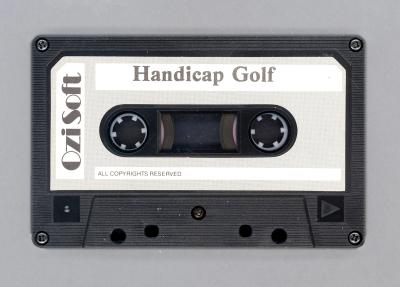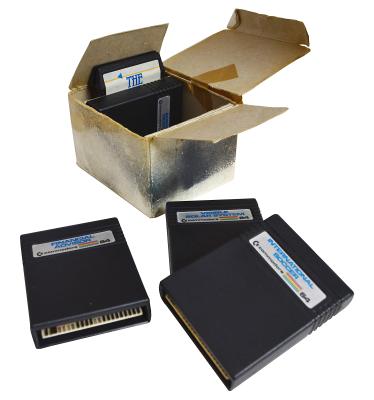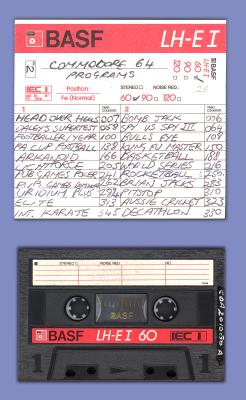GAME HANDICAP GOLF PACKAGING FOR COMMODORE 64 COMPUTER
c. 1982 - 1994Clear, rectangular, plastic folder.
The front cover folds out to enable access to a moulded rectangle plastic indentation with pyramid shaped prongs in middle. Moulded into this indentation is [MANUFACTURED BY / AACTION PLASTICS CO. / SYDNEY / PHONE (02) 674 2323].
There is a square sheet of black stiff card, with grey horizontal stripes around the border and a green inner panel, and the image of a male dressesd in golf gear with a club at the end of his swing. There is a yellow sticker with black text in the top left [C64/128 / Casette] and text [OZISOFT / HANDICAP GOLF / CRL / RELEASED THROUGH OZISOFT. ALL COPYRIGHTS RESERVED].
On the back of this card is instructions on how to load and play the game.
The Commodore 64, also known as C64, was a home computer introduced in January 1982 by Commodore International. The C64 name came from its 64 kilobytes of RAM. Retailing at US$595 (equivalent to $1545 USD in 2018) and selling 17 million units worldwide during its lifetime, it was listed in the Guinness Book of World Records as being the highest-selling single computer model of all time. Between 1983 and 1986, the C64 outsold its competitors' products, IBM PC Compatibles, Apple Computers, and Atari 8-bit. This was achieved through selling at regular retail stores, rather than at electronics and computer specialist stores. Aproximately 10,000 software titles were made for the C64, including office productivity applications, development tools and video games. It was discontinued in April 1994, although it remains popular in society today with collectors and computer enthusiasts. In 2018, the C64 mini 'retro' console was announced, introducing a new generation to the wonders of the C64.
Details
Details
OZISOFT AACTION PLASTICS CO.
This object is part of a collection that represents the types of technology that were used on a daily basis by people who lived in worked in the City of Armadale. The collection represents how technology has influenced how people lived, worked and played within the City of Armadale. The collection also is representative of how technology evolves and can become obsolete which in turn can make pastimes, jobs and skills evolve or become obsolete.
City of Armadale - History House
City of Armadale - History House
Other items by ozisoft
More items like this
Other items from City of Armadale - History House
- CASSETTE FOR COMMODORE 64 COMPUTER
- CASSETTE CASE FOR COMMODORE 64 COMPUTER GAME
- CASSETTE FOR COMMODORE 64 COMPUTER
- CASSETTE CASE FOR COMMODORE 64 COMPUTER GAME
- CASSETTE FOR COMMODORE 64 COMPUTER
- CONTAINER, CASSETTE - WITH LIST OF PROGRAMS ON TAPE
- 5¼ DISK FOR COMMODORE 64 COMPUTER
- 5¼ DISC FOR COMMODORE 64 COMPUTER
- INSTRUCTION PAMPHLET FOR SOFTWARE C64 COMPUTER
- INSERT, PACKAGING - FOR MAGNETIC TAPES / CASSETTES
- CASSETTE FOR COMMODORE 64 COMPUTER
- CASSETTE FOR COMMODORE 64 COMPUTER






